The 3 fashion product strategiesHow to align product and brand strategy to create a profitable fash
eandage dress brand Hervé Léger was a 2000s staple. Their bandage cocktail dresses and skirts hugged women into the classic ‘going out look’ years before Kim K’s body-contouring SKIMS entered the scene. Cindy Crawford, Kim Kardashian, Gisele Bundchen, Elle Macpherson, Rihanna, and Victoria Beckham in Hervé Léger bandage dresses. Source: Mirror, Glamour
Cindy Crawford, Kim Kardashian, Gisele Bundchen, Elle Macpherson, Rihanna, and Victoria Beckham in Hervé Léger bandage dresses. Source: Mirror, Glamour
And then… Hervé Léger dresses disappeared. The brand (and parent BCBG) went bankrupt in 2017. At a podcast interview hosted by Glossy, Hervé Léger’s new CEO Melissa Lefere-Cobb said that the brand failed to maintain relevant product:
We had gone from skin tight bandage dresses and sky high Louboutin [heels] to the Zimmerman effect and a more ethereal flowy way of dressing.
— Melissa Lefere-Cobb, Glossy
When styles changed from body-contouring to bohemian, Hervé Léger’s bandage dresses did not have a place.
Clothing brands have it tough. High-end accessories — a Hermès handbag, a Cartier watch — are allowed to repeat similar styles. Instead of evolving those kinds of products, you evolve the world around it. Change the merchandising. Pair a Chanel flap purse with a blazer one season, and a flowy gown the next. The brand is still relevant.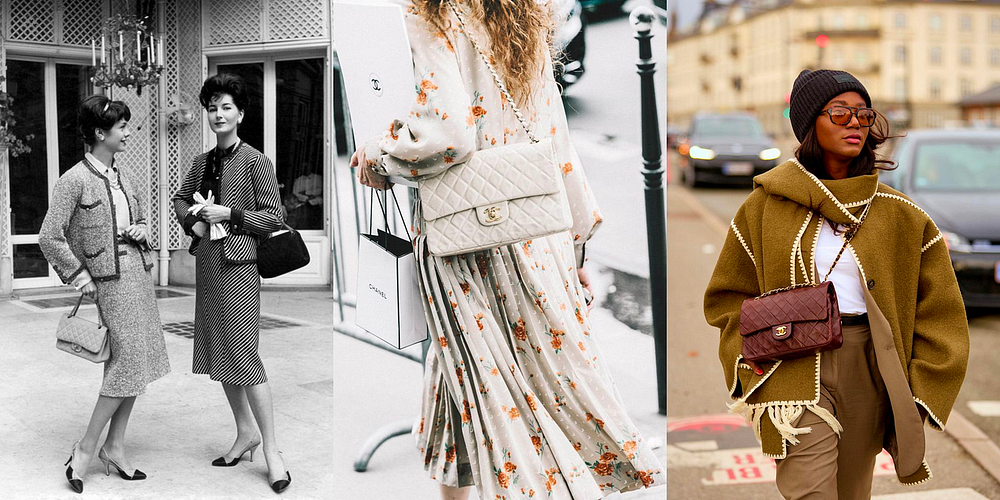 Chanel bags are long-lasting accompaniments for changing trends. Source: Pinterest
Chanel bags are long-lasting accompaniments for changing trends. Source: Pinterest
But an evening dress is meant for an evening. Once you own one Hervé dress, you don’t really need another — lest you look like you only have one going out style. Successful evening brands constantly evolve new looks; they don’t repeat signature looks.
But Michelle — don’t you often write about the importance of product signatures for strong brands? What about Hoka’s thick sole, Rimowa’s vaulted luggage, and Moncler’s iconic puffer coat?
Yes — product signatures are key brand assets. But they don’t make sense for every business. The strength of the signature is a function of how much a customer is supposed to repeat that item. Long-lasting items (jewelry, classic handbags) should repeat brand elements as much as possible. Items meant for an event lose value with a repeated signature. A Zara outfit is for one heavily photographed evening. Its value comes from being on trend and owning something new.
This relationship reveals (3) categories for fashion products:
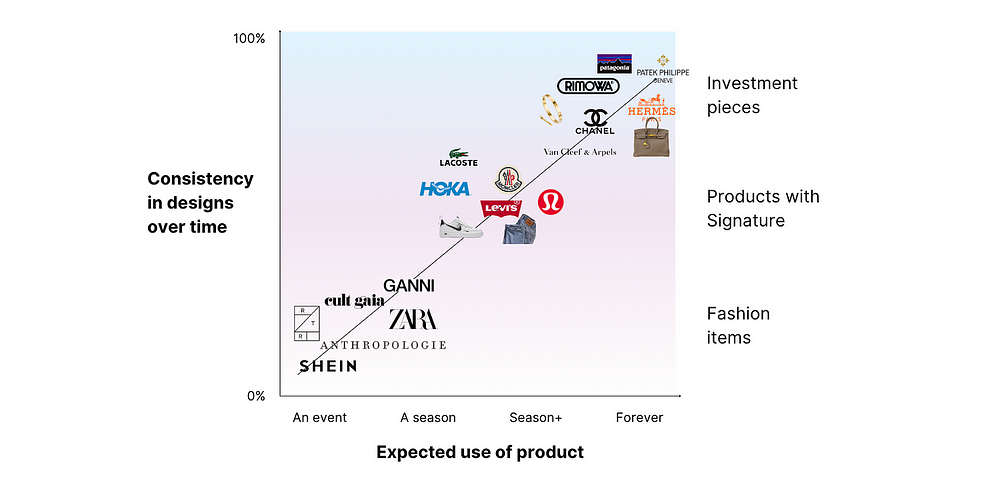 Fashion Brand/Product strategy. Source: Michelle Wiles
Fashion Brand/Product strategy. Source: Michelle Wiles
1. Investment pieces —
This is your expensive jewelry, Rolex watch, and Hermès handbag. Typically accessories, these items are not meant to change much. That would detract from their brand promise: that these products last. Brand managers refresh these brands by reimagining a world around the product, as opposed to the product itself. Tiffany adorns a priceless diamond (owned since 1877) onto a new icon (Beyoncé) for their brand refresh.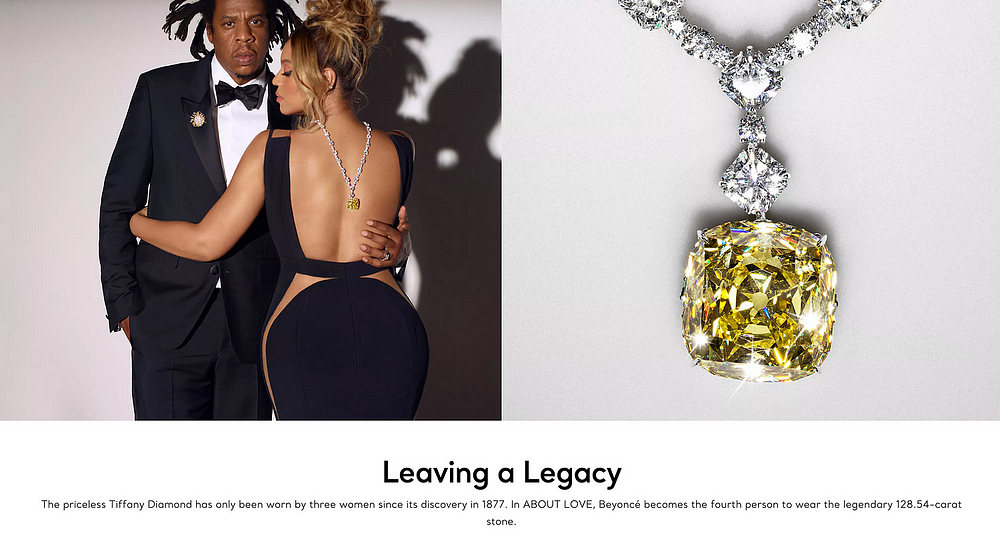 New worlds refresh iconic products. Source: Tiffany
New worlds refresh iconic products. Source: Tiffany
2. Products with signature —
These are products you repeat for a season to a few years. A pair of jeans. A pair of sneakers. A coat. These items should have a defining quality (signature) that tie product together. The signature should be memorable enough to link different SKUs to the brand, but flexible to allow for new styles over time. Hokas yesterday and Hokas today still feature the Hoka outsized sole. But they have modernized over time. The Levis patch is flexible enough to go from wide leg jeans to skinny jeans and back.
(A quick aside: If you’re enjoying this article, consider subscribing to my free weekly newsletter, Branding in 4-D, by clicking here!)
3. Fashion items —
These are items bought with the benefit of being on trend and/or new. A dress you wear to a wedding fits here. You don’t want to re-wear what you wore in photos already. Zara executes this category well — there is little to no repeatable signature in its clothing from one season to the next.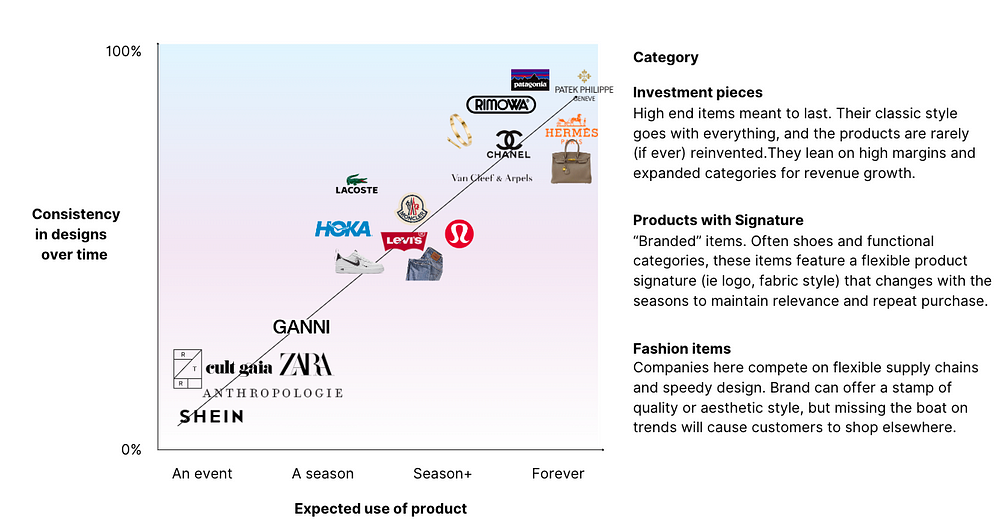 Fashion Brand/Product strategy. Source: Michelle Wiles
Fashion Brand/Product strategy. Source: Michelle Wiles
Hervé Léger attempted something very tough.
They operated in a single-use category — evening wear. But, they branded their product like an icon. Every dress and skirt was a similar evocation of the bandage material. Once the body-hugging trend was over, the brand was outdated.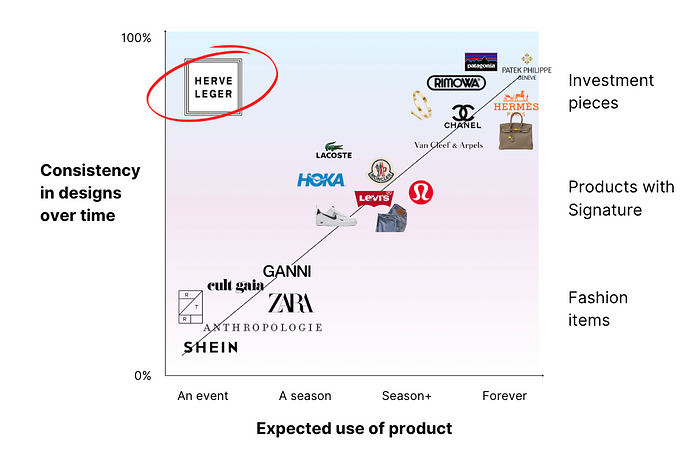 Hervé Léger paired a consistent aesthetic in a category that demands newness (eveningwear) leaving the company at the whims of changing trends. Source: Michelle Wiles
Hervé Léger paired a consistent aesthetic in a category that demands newness (eveningwear) leaving the company at the whims of changing trends. Source: Michelle Wiles
Bringing Hervé Back
The good news is that the framework identifies where Hervé can go now that it has been bought out of bankruptcy. A dress is not meant to be worn daily for years, so the Investment piece strategy is out.
Hervé could attempt a move into Fashion items. Hervé Léger would be a brand in name only, with a slew of sexy styles that change every few months, and lack of repeated signature. Given that Hervé still holds strong awareness in the bandage material, this shift would involve a costly loss of brand equity in their signature, plus it would require investments in a Zara-style supply chain.
The final option — shift to being a Product Signature brand — makes the most sense. Hervé could own bandage knit as its signature, and release regular collections around it. But to succeed, Hervé needs to shift out of evening wear, and loosen the consistency of their signature style, just a bit. Instead, they can make the bandage a flexible signature across casual wear: dresses for Hamptons lounging, slimming skirts for work, and colorful stretch swimwear.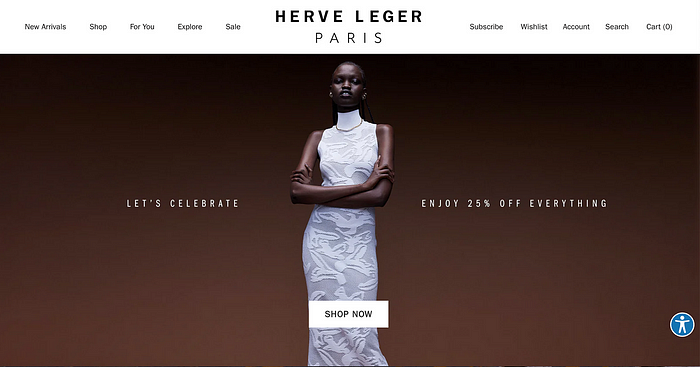 Hervé Léger’s home page focuses on evening
Hervé Léger’s home page focuses on evening
The brand is on its way. The website still anchors on evening wear, but now features a few business jumpsuits, some casual-wear, and last week announced — swimsuits. I figure they are testing the waters here (literally and figuratively).
If I were running Hervé Léger — I’d push this even further. Make high-end casual wear the hero item. Offer a line of stretchy / sexy workwear, and do a collaboration with Theory to get distribution access to women shopping for new office outfits. Build out a lounge collection with Zimmerman that offer both flowy skirts and cinched bandage waists. Broaden Hervé Léger into an ever-changing platform for riffs on the bandage material. So that when I visit this year I can stock up on trendy bandage tube tops and midi pencil skirts. And next year, when the no-pants look, corsets, and capri pants supposedly come back into the mainstream, Hervé Léger is there to offer their bandage take on it.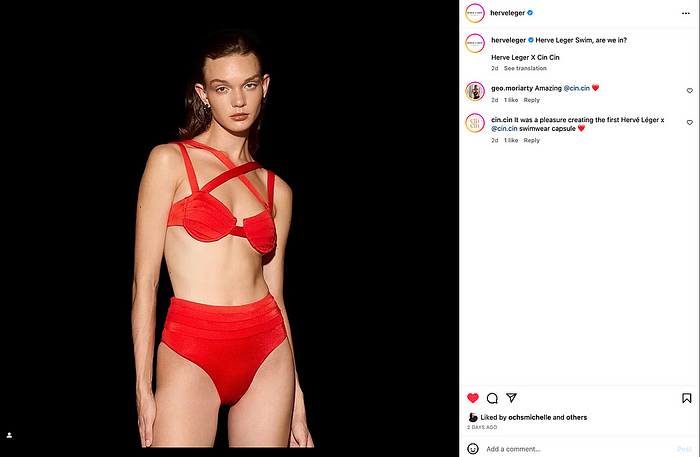 A new swim collection. Source: Instagram
A new swim collection. Source: Instagram
In short, a product shift to casual wear, and a looser but still recognizable product signature in bandage material will help Hervé Léger build a long term brand, both culturally (as the bandage earns more staying power) and financially (as women have a reason to shop the brand more than once).
Can other brands use this framework?
Yes! The first step is to map where you are:
- Expected use: what is the role of your product to consumers? Is it something you show off forever? For a season? For an event?
- Consistency of design: how consistent are your key products — across your product range? From year to year?
If you’re on the line, that’s a good thing. It means your product strategy fits the category. From there, you can work on differentiating your brand. Investment pieces tend to brand around craftsmanship and history. Product signatures root themselves in a double base of technical superiority and an idealized customer persona. Fashion items own newness and offer a specific style perspective (e.g. bohemian Free People to Theory’s riffs on modern workwear). If you want to discuss your brand positioning, send me an email.
If you’re not on the line, decide how you want to update your products, your category, or both (in the example of Hervé).
What do you think about the framework?
If you liked this article, follow me and sign up for my newsletter. You’ll receive exclusive content on marketing strategy.
Looking for help growing your brand?
I run brand consultancy Embedded — where I partner with companies to grow via strategic marketing.
Not sure where to start? Many clients opt for ad-hoc coaching — hourly consultations on any aspect of your marketing and brand strategy. Get in touch here, or book a 15 minute free consultation.











































